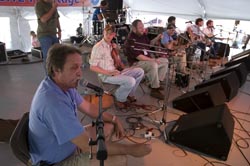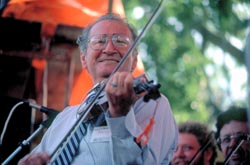Cultivating Folk Buds: The Horti-culture of Folk Studies
By Barry Jean Ancelet
The name Louisiana Folk Roots implies a validation and veneration of the past, but the past is only part of our story. Preserving the past for its own sake can only produce a museum or preservation hall filled with the wonderful things that used to be. It is at least as important to consider the ‘folk buds’ of the present and the future as well.
The real challenge of folklore and cultural studies is to discover and understand the past so that it can serve to inform the present and define the future in the most appropriate ways. With the digital, electronic and cyber resources currently available, it is easy to import culture willy-nilly from anywhere. If we are not to lose ourselves in what Alan Lomax called a ‘cultural gray-out,’ we must celebrate and practice what is our own. But in order to do that, we must first know what is truly ours and we must prize it. And if what is our own is to affect the way we live and the way we will live, we must learn to use it to improvise and create new expressions of it on its own terms.

Culture is not a static product, but a dynamic, ongoing process. Organic change that comes from the inside is not a problem, it is necessary to the very existence of culture. As Cajun musician and cultural activist Dewey Balfa so eloquently put it, ‘I‘m interested in the very life of this culture and how it continues to evolve on its own terms. I don‘t want to freeze-dry it or pin it to a wall like a dead butterfly’
Over the years, and especially since the 1970s, a new generation of Cajun and Creole scholars has studied the past, driven by a desire to understand who we are and why we are the way we are: why we sing the songs we sing, eat the foods we eat, build the houses we build, tell the stories we tell, work and play the ways we do, what makes us laugh and what gives us the frissons, the chills and goosebumps we feel in the presence of real culture and real emotion.
The first Tribute to Cajun Music Concert in 1974, as well as the issues that emerged and evolved as the concert became an annual festival, was one of the first expressions of this folklore study. The programming of the festival was based on an integration of ideas that grew out of two distinct camps: on the one hand, activist folklife-based considerations as influenced by the Smithsonian Institution‘s Festival of American Folklife; and on the other, linguistic-based considerations that grew out of The Council for the Development of French in Louisiana‘s language and cultural preservation initiatives.
Fieldwork and programming practices evolved based on a desire to discover and present excellent folk performers from real-life (authentic) contexts, avoiding the more self-conscious, public purveyors of folkloric (authentic-like) culture. The fieldwork practices that grew out of the festival experience also contributed to the collection and analysis of other traditional genres in French Louisiana, including oral tradition and material culture. Selecting the collection of performers who would essentially define the moment in Cajun music and zydeco each year posed interesting problems and opportunities for festival producers, including the incorporation of young performers and the new, emerging styles that are necessarily part of living traditions.
Balfa, the festival‘s conscience, was not only a musician, but what folklorists have come to call a community scholar, a member of a folk community who has learned to address the issues that are at the heart of the study and practice of folklore, such as cultural equity, described by Alan Lomax as the relationship between preservation and innovation within the traditional context. I learned at least as much from Dewey as from any professor I ever had in a formal university setting. The fieldwork we did for the festival was a natural extension of the activist field-work that had begun when John and Alan Lomax began collecting folksongs for the Library of Congress in the 1930s. Our initial effort was an overwhelming success, surprising even the most enthusiastic of our collaborators, packing Lafayette‘s Blackham Coliseum despite lightning, thunder and driving rain. The event turned out to be the largest mass rally of what would come to be called the Louisiana French renaissance movement.
We saw the opportunity to use the energy produced by this initial concert to fuel a long-term project. Balfa, who had seen the benefit of the archives at the Library of Congress and the Smithsonian institution, insisted on the establishment of a similar bank of information on ourselves here in Louisiana. When I pointed out that we did not have the financial resources to create an archive, Balfa pointedly asked, ‘Do you have enough money to buy a tape?’ I answered yes, and he continued, ‘Then buy one and go out and record an interview and put that tape on a shelf. Then record another one when you can afford it. And when you put that second tape next to the first one on the shelf, you have the beginnings of an archive.’
He was right, as usual; the beginnings of the archive were just that homemade. About the same time, the Council for the Development of French in Louisiana bought dozens of tapes and funded early recording efforts, using the fieldwork tapes in French radio programming. The Rockefeller Foundation also provided critical support, buying hundreds of additional reels of tape. We also contacted folklorists who had worked in Louisiana in the past, including the Lomaxes, Harry Oster and Ralph Rinzler and obtained copies of their fieldwork materials. Other collections, such as those of Elizabeth Brandon, William Owen and Corinne Saucier were also obtained.
Now, gathered in one place for the first time, these materials provided a sense of the evolution and development of Cajun and Creole music from unaccompanied ballad tradition to contemporary dance band styles. Fieldwork on oral tradition and material culture was added as well. And the ongoing field recordings of students and colleagues continue to enrich our understanding of Louisiana‘s Cajun and Creole cultures.
But the collection was never intended to be an end in itself. Instead, it has served as a resource for cultural recycling. For example, when the Center for Cajun and Creole Folklore acquired copies of the Lomaxes‘ 1934 field recordings, our goal was not only to repatriate this important research. We provided copies to the families of the original performers and encouraged contemporary musicians to use the collection as a source for ‘new’ traditional material.
In this spirit, the Center organizes festivals and special performances, television and radio programs, and offers classes and workshops through the university‘s graduate programs in Francophone Studies and English. The Center also produces books, articles and recordings that communicate new discoveries and interpretations to community members as well as scholars.
Not too long ago there were precious few books and articles available on Cajun and Creole culture, and most of those were written by outsiders who often misrepresented our cultures because they lacked an in-depth understanding of them. I became interested in writing books and articles because I wanted to try to reverse that trend. But books and articles do not necessarily reach the large audiences of Cajuns and Creoles who need access to information about themselves. So the Center has explored other ways to disseminate its findings. We‘ve joined forces with record producers to release commercial recordings based on the fieldwork we‘ve collected. We‘ve partnered with radio producers and filmmakers to produce special programs and documentaries based on the fieldwork we‘ve collected. And we continue to collaborate with educational institutions to present singers and storytellers in classes and special lecture series.
Student and faculty researchers have focused on a wide range of subjects, including the traditional Mardi Gras, traiteurs (faith healers), folk religion, folk justice, traditional humor, social institutions, foodways, dances and material culture. This research typically focuses on contemporary as well as historical aspects of the issues, reflecting Dewey Balfa‘s concern for considering folklore as a vital ongoing process rather than as a stagnant product.
The roots and development of Cajun and Creole folklore are actively explored, taking researchers back to the regions of France (especially Poitou, Vendee and Bretagne) that provided most of the French settlement of Louisiana, as well as the other major sources of influence, including Spain, Germany, England, Ireland, Quebec and the Acadian Maritimes, the West Indies and Africa. Of particular interest is the process of creolization, the unique blending of cultures that occurred in Louisiana to produce the folk architecture, music, oral tradition and cuisine of the region. Through this range of activities, we try to integrate both sides of folkloristics, the scholarly and the public, without getting caught in the perceived trap between the two.
For my own part, I became involved in fieldwork quite simply because I realized that it was the only way to reach the information that was missing from the record. The most important untapped source for information on the Cajuns and Creoles is the Cajuns and Creoles themselves. The fieldwork-based approach of folklore studies provided a method to reach that source. Its naturally interdisciplinary nature, necessarily integrating considerations of history and art, text and context, provided the wide range of approaches needed to understand the complexities of culture and tradition, including oral tradition, traditional music, vernacular architecture, folk art and seasonal rituals, among other cultural expressions. Folklore studies also led to considerations of important cultural and social issues such as conservation, transmission and innovation within the context of tradition.
It is not necessarily a good idea, nor is it even possible, to preserve everything from the past. In the first place, things evolve in a natural, culturally and socially organic way. If we tried to preserve everything, where would it end? When would we get around to living and enjoying the natural evolution of society and culture? As Balfa said, ‘A culture is preserved one generation at a time.’
While I‘d love to take a trip back in time to a Saturday night house dance in 1928 to hear Amede Ardoin and Dennis McGee perform, our real challenge is to figure out how to be Cajuns and Creoles in the 21st century. It is important to insure that the next generation knows as much as we can gather about Ardoin and McGee, but it is even more important that the next generation knows how Ardoin and McGee did what they did, so that someone from our time might have a chance to take us into the future in a culturally meaningful and responsible way.
For our efforts to work, we‘ve got to consider the whole tree. We water the roots so the buds will grow.



